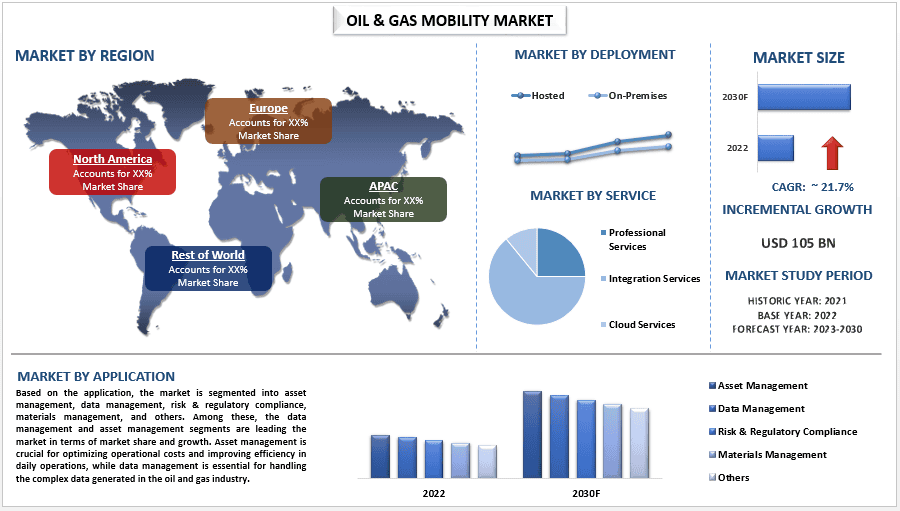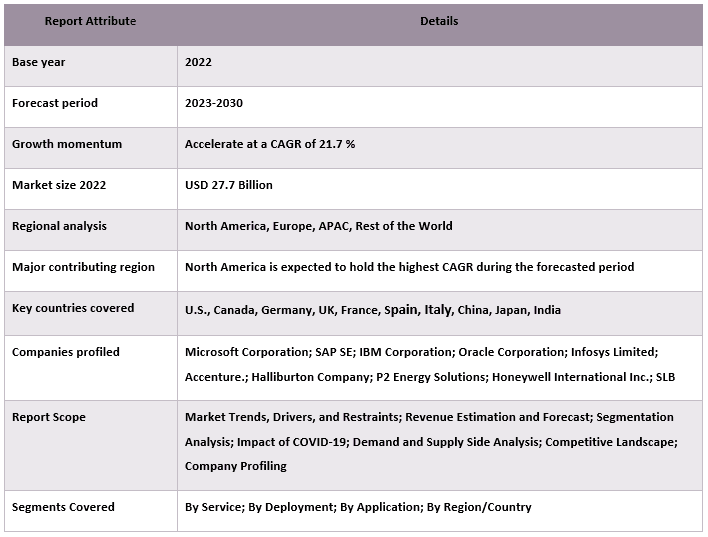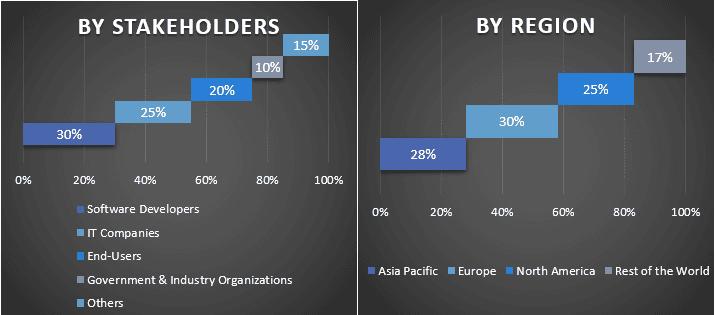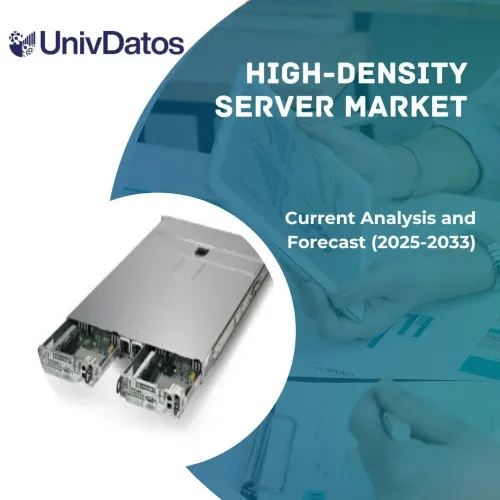- Accueil
- À propos de nous
- Industrie
- Services
- Lecture
- Contactez-nous
Marché de la mobilité pour le secteur pétrolier et gazier : Analyse actuelle et prévisions (2023-2030)
Accent mis sur les services (services professionnels, services d'intégration et services cloud); Déploiement (hébergé et sur site) ; Application (gestion des actifs, gestion des données, conformité réglementaire et gestion des risques, gestion des matériaux, et autres) et région/pays.

Marché de la mobilité pour le secteur pétrolier et gazier – Scénario actuel et prévisions
Le marché de la mobilité pour le secteur pétrolier et gazier était évalué à 27,7 milliards en 2022 et devrait croître à un rythme soutenu d'environ 21,7 % au cours de la période de prévision (2023-2030) en raison du besoin croissant d'optimiser les coûts opérationnels, de gérer les données complexes et d'améliorer l'efficacité des opérations quotidiennes.Les marchés de la mobilité pour le secteur pétrolier et gazier désignent les diverses plateformes et solutions numériques qui permettent aux entreprises du secteur de l'énergie de gérer plus efficacement leurs opérations logistiques, de transport et de chaîne d'approvisionnement. Ces solutions peuvent inclure des applications mobiles pour les travailleurs sur le terrain, des systèmes de gestion de flotte et des outils d'analyse de données pour optimiser les itinéraires de livraison et réduire les coûts. La demande croissante de transport efficace et durable est un facteur clé, entraînant l'adoption de technologies mobiles pour optimiser les coûts opérationnels et améliorer l'efficacité des opérations quotidiennes. De plus, le marché se caractérise par une forte concurrence entre les fabricants, favorisant l'innovation continue et l'introduction de nouveaux produits et services. De même, le passage à des solutions de mobilité plus propres et plus durables offre des opportunités d'expansion du marché pour les constructeurs automobiles, les entreprises énergétiques et les fournisseurs de technologies, contribuant ainsi à la croissance du marché.
Certains des principaux acteurs opérant sur le marché incluent Microsoft Corporation ; SAP SE ; IBM Corporation ; Oracle Corporation ; Infosys Limited ; Accenture. ; Halliburton Company ; P2 Energy Solutions ; Honeywell International Inc. ; SLB.
Aperçu des informations présentées dans le rapport
« Parmi les services, le segment des services professionnels détient la plus grande part du marché au cours de la période de prévision. »
Le marché est segmenté par service en services professionnels, services d'intégration et services cloud. Le segment des services professionnels représente la plus grande part des revenus du marché de la mobilité pour le secteur pétrolier et gazier, principalement parce que ces services comprennent le conseil, la mise en œuvre et la formation offerts par des fournisseurs expérimentés qui guident les clients tout au long du processus complexe de déploiement de solutions mobiles au sein de leurs organisations.
« Parmi les déploiements, le segment sur site détient une part importante au cours de la période de prévision. »
Selon le déploiement, le marché est divisé en hébergé et sur site. Le segment sur site est actuellement en tête en raison de facteurs tels qu'un plus grand contrôle de la sécurité des données et des options de personnalisation qui ne sont disponibles qu'avec une solution sur site.
« L'Amérique du Nord devrait détenir une part importante du marché en 2022. »
L'Amérique du Nord détient une part de marché importante en 2022 grâce aux avantages tirés de l'activité des schistes bitumineux. Cela a conduit à une adoption accrue des technologies mobiles pour optimiser les coûts opérationnels et améliorer l'efficacité des opérations quotidiennes. De plus, l'industrie pétrolière et gazière d'Amérique du Nord a été à l'avant-garde de ces avancées, qui ont stimulé l'adoption des technologies et des applications mobiles sur le marché de la mobilité pour le secteur pétrolier et gazier. De même, les centres énergétiques régionaux, tels que le golfe du Mexique et le bassin permien, ont joué un rôle important dans l'adoption de la mobilité en Amérique du Nord, faisant de la région un acteur majeur du marché de la mobilité pour le secteur pétrolier et gazier.
Couverture du rapport sur le marché de la mobilité pour le secteur pétrolier et gazier

Raisons d'acheter ce rapport :
- L'étude comprend une analyse de dimensionnement et de prévision du marché validée par des experts clés du secteur authentifiés.
- Le rapport présente un aperçu rapide des performances globales du secteur en un coup d'œil.
- Le rapport couvre une analyse approfondie des principaux acteurs du secteur, en mettant l'accent sur les principaux indicateurs financiers, le portefeuille de produits, les stratégies d'expansion et les développements récents.
- Examen détaillé des facteurs, des contraintes, des principales tendances et des opportunités prévalant dans le secteur.
- L'étude couvre de manière exhaustive le marché dans différents segments.
- Analyse approfondie du marché au niveau régional.
Options de personnalisation :
Le marché mondial de la mobilité pour le secteur pétrolier et gazier peut être personnalisé en fonction des exigences ou de tout autre segment de marché. En outre, UMI comprend que vous pouvez avoir vos propres besoins commerciaux. N'hésitez donc pas à nous contacter pour obtenir un rapport qui correspond parfaitement à vos besoins.
Table des matières
Méthodologie de recherche pour l'analyse du marché de la mobilité pour le secteur pétrolier et gazier(2023-2030)
L'analyse du marché historique, l'estimation du marché actuel et la prévision du marché futur du marché mondial de la mobilité pour le secteur pétrolier et gazier ont été les trois étapes majeures entreprises pour créer et analyser l'adoption du marché de la mobilité pour le secteur pétrolier et gazier dans les principales régions du monde. Une recherche secondaire exhaustive a été menée pour collecter les chiffres historiques du marché et estimer la taille actuelle du marché. Deuxièmement, pour valider ces informations, de nombreuses constatations et hypothèses ont été prises en considération. De plus, des entretiens primaires exhaustifs ont également été menés avec des experts du secteur tout au long de la chaîne de valeur du marché mondial de la mobilité pour le secteur pétrolier et gazier. Après l'hypothèse et la validation des chiffres du marché par le biais d'entretiens primaires, nous avons utilisé une approche descendante/ascendante pour prévoir la taille complète du marché. Par la suite, des méthodes de ventilation du marché et de triangulation des données ont été adoptées pour estimer et analyser la taille du marché des segments et sous-segments du secteur concerné. La méthodologie détaillée est expliquée ci-dessous :
Analyse de la taille historique du marché
Étape 1 : Étude approfondie des sources secondaires :
Une étude secondaire détaillée a été menée pour obtenir la taille historique du marché de la mobilité pour le secteur pétrolier et gazier grâce à des sources internes à l'entreprise telles querapports annuels et états financiers, présentations de performances, communiqués de presse, etc.,et des sources externes, notammentjournaux, actualités et articles, publications gouvernementales, publications des concurrents, rapports sectoriels, bases de données tierces et autres publications crédibles.
Étape 2 : Segmentation du marché :
Après avoir obtenu la taille historique du marché de la mobilité pour le secteur pétrolier et gazier, nous avons mené une analyse secondaire détaillée pour recueillir des informations historiques sur le marché et des parts pour différents segments et sous-segments pour les principales régions. Les principaux segments sont inclus dans le rapport, tels que le service, le déploiement et l'application. De plus, des analyses au niveau des pays ont été menées pour évaluer l'adoption globale des modèles de tests dans cette région.
Étape 3 : Analyse factorielle :
Après avoir acquis la taille historique du marché des différents segments et sous-segments, nous avons mené uneanalyse factorielledétaillée pour estimer la taille actuelle du marché de la mobilité pour le secteur pétrolier et gazier. De plus, nous avons mené une analyse factorielle en utilisant des variables dépendantes et indépendantes telles que divers services, déploiements et applications du marché de la mobilité pour le secteur pétrolier et gazier. Une analyse approfondie a été menée des scénarios de l'offre et de la demande en tenant compte des principaux partenariats, fusions et acquisitions, de l'expansion des activités et des lancements de produits dans le secteur du marché de la mobilité pour le secteur pétrolier et gazier dans le monde entier.
Estimation et prévision de la taille actuelle du marché
Dimensionnement actuel du marché :Sur la base d'informations exploitables issues des 3 étapes ci-dessus, nous sommes parvenus à la taille actuelle du marché, aux principaux acteurs du marché mondial de la mobilité pour le secteur pétrolier et gazier et aux parts de marché des segments. Toutes les parts de pourcentage requises, les répartitions et les ventilations du marché ont été déterminées à l'aide de l'approche secondaire susmentionnée et ont été vérifiées par des entretiens primaires.
Estimation et prévision :Pour l'estimation et les prévisions du marché, des pondérations ont été attribuées à différents facteurs, notamment les moteurs et les tendances, les contraintes et les opportunités disponibles pour les parties prenantes. Après avoir analysé ces facteurs, des techniques de prévision pertinentes, c'est-à-dire l'approche descendante/ascendante, ont été appliquées pour parvenir aux prévisions du marché pour 2030 pour différents segments et sous-segments sur les principaux marchés à l'échelle mondiale. La méthodologie de recherche adoptée pour estimer la taille du marché englobe :
- La taille du marché du secteur, en termes de revenus (USD) et le taux d'adoption du marché de la mobilité pour le secteur pétrolier et gazier sur les principaux marchés au niveau national
- Toutes les parts de pourcentage, les répartitions et les ventilations des segments et sous-segments de marché
- Les principaux acteurs du marché mondial de la mobilité pour le secteur pétrolier et gazier en termes de produits offerts. De même, les stratégies de croissance adoptées par ces acteurs pour concurrencer sur le marché en croissance rapide.
Validation de la taille et de la part de marché
Recherche primaire :Des entretiens approfondis ont été menés avec les Key Opinion Leaders (KOL) comprenant les Top Level Executives (CXO/VP, Responsable des ventes, Responsable marketing, Responsable des opérations, Responsable régional, Responsable pays, etc.) dans les principales régions. Les résultats de la recherche primaire ont ensuite été résumés, et une analyse statistique a été effectuée pour prouver l'hypothèse énoncée. Les données de la recherche primaire ont été consolidées avec les résultats secondaires, transformant ainsi l'information en informations exploitables.
Répartition des participants primaires dans différentes régions

Ingénierie de marché
La technique de triangulation des données a été employée pour compléter l'estimation globale du marché et pour obtenir des chiffres statistiques précis pour chaque segment et sous-segment du marché mondial de la mobilité dans l'industrie du pétrole et du gaz. Les données ont été divisées en plusieurs segments et sous-segments après avoir étudié divers paramètres et tendances dans les domaines du service, du déploiement et de l'application sur le marché mondial de la mobilité dans l'industrie du pétrole et du gaz.
L'objectif principal de l'étude du marché mondial de la mobilité dans l'industrie du pétrole et du gaz
Les tendances actuelles et futures du marché mondial de la mobilité dans l'industrie du pétrole et du gaz ont été mises en évidence dans l'étude. Les investisseurs peuvent obtenir des informations stratégiques pour baser leur discrétion en matière d'investissements sur l'analyse qualitative et quantitative effectuée dans l'étude. Les tendances actuelles et futures du marché ont déterminé l'attractivité globale du marché au niveau régional, fournissant une plate-forme aux participants industriels pour exploiter le marché inexploité afin de bénéficier d'un avantage du premier arrivé. Les autres objectifs quantitatifs des études comprennent :
- Analyser la taille actuelle et prévue du marché de la mobilité dans l'industrie du pétrole et du gaz en termes de valeur (USD). De plus, analyser la taille actuelle et prévue du marché des différents segments et sous-segments.
- Les segments de l'étude comprennent les domaines du service, du déploiement et de l'application.
- Définition et analyse du cadre réglementaire de l'industrie du marché de la mobilité dans l'industrie du pétrole et du gaz.
- Analyser la chaîne de valeur impliquée avec la présence de divers intermédiaires, ainsi qu'analyser les comportements des clients et des concurrents de l'industrie.
- Analyser la taille actuelle et prévue du marché de la mobilité dans l'industrie du pétrole et du gaz pour la région principale.
- Les principaux pays des régions étudiées dans le rapport comprennent l'Asie-Pacifique, l'Europe, l'Amérique du Nord et le reste du monde.
- Profil de l'entreprise du marché de la mobilité dans l'industrie du pétrole et du gaz et les stratégies de croissance adoptées par les acteurs du marché pour se maintenir sur le marché en forte croissance.
- Analyse approfondie du niveau régional de l'industrie
Questions Fréquemment Posées FAQ
T1: Quelle est la taille actuelle du marché mondial de la mobilité pour le pétrole et le gaz et son potentiel de croissance ?
T2 : Quels sont les facteurs moteurs de la croissance du marché mondial de la mobilité pour le pétrole et le gaz ?
T3 : Quel segment détient la plus grande part du marché mondial de la mobilité pour le pétrole et le gaz par application ?
T4 : Quelle région dominera le marché mondial de la mobilité pour le pétrole et le gaz ?
T5 : Qui sont les principaux acteurs du marché mondial de la mobilité pour le pétrole et le gaz ?
Connexes Rapports
Les clients qui ont acheté cet article ont également acheté










